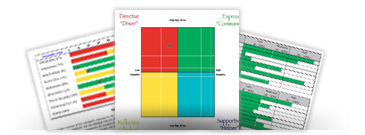What’s the best selling style for B2B salespeople?

A sales predictor assessment can shed a lot of light into the personality traits of your sales candidates and whether they make a good fit for your company. It also informs as to the selling style each is likely to use.
Is one selling style better than others for B2B salespeople? The answer is: it depends. Some products and services require long and complex sales cycles which benefit from one style, while some businesses do better with another. However, there is one style that works best overall.
Ready to find out what it is? Also, learn about each major selling style’s strengths and weaknesses.
Transactional
New salespeople tend to fall into a transactional style of selling, where they focus on the benefits of the product or service and are busy telling the buyer all about them. A great example of this is the typical tradeshow pitch.
This style is often maligned but can actually work well with commoditized products or services where there really isn’t much difference in quality (copy paper, cleaning services, maintenance, office furniture). Transactional salespeople tend to compete on lowest price, faster delivery, longer payment cycles, better warranties and things of that nature rather than intrinsic product characteristics.
Sometimes, buyers drive salespeople into this type of style. They just want to get the best price possible and don’t want to know about anything else. Elite salespeople still manage to find out more about the buyer and her business through effective questioning, intentional listening, and setting themselves apart even when selling commodities.
Of all selling styles, this can get the most immediate results, but is the weakest for long term success.
Persuasive
A step up from a purely transactional selling style is the persuasive style. A seller using this style goes deeper with demonstrations, ROI calculations, charts, diagrams, and other methods to convince the customer. They follow up quite a bit and can actually get on prospect’s nerves as “pushy” – but they DO close sales.
A sales predictor assessment would show an individual who prefers this style has lots of drive and need for recognition as personality traits. The problem with this style is that adopters can turn off buyers because they come across as overbearing.
Persuasive sellers would be well served to adopt a few of the tactics of the next selling style: the consultant/collaborator.
Consultative/Collaborative

Volumes have been written about using a consultative approach when selling. It is a better style to adopt for B2B sales because it allows salespeople to focus on listening rather than talking over the customer. This allows them to uncover needs more effectively than a purely Persuasive seller.
Becoming a trusted adviser involves collaborating with the customer to come up with solutions. Some collaborators almost consider themselves part of the buyer’s business and think like an employee or partner.
The problem with this style is that it can take a long time to close anything, and sellers could literally be dispensing free advice with nothing to show for it ever. It is sad to see the new salesperson who adopts this style, has endless meetings and expensive outings with the prospect, reports on the “great relationship” they have established – only to lose the deal to a more aggressive salesperson who swoops in suddenly. It can be crushing.
The solution is for this type of salesperson to get small orders along the way to the big sale. In that way, they can prove themselves while not being taken advantage of. If the buyer is never willing to part with any money at all, the big sales will likely never come.
Sales predictor assessments reveal sellers with this style have a strong need to serve, are optimistic, and have a lot of empathy for others.
Challenger
The Challenger Sale put a name to a selling style elite salespeople have been using for decades but never had a succinct name for. According to the book, most top performers use this style, and I would concur.
I mentioned earlier that persuasive sellers would be well served to adopt some of the traits of consultative sellers, and that’s what I feel a challenger style is: driven and convincing, but with a deep sense of the buyer’s business through effective listening. These salespeople “challenge” their customers to look at things differently rather than act as Yes-men just to get the sale.
For B2B sales, the challenger style works for most scenarios, making it the overall winner!
To sum up, every selling style can produce results. Sell in the way that is most successful for YOU and that aligns with the results of your sales predictor assessment. What I have seen over the years is that no matter the style, the best salespeople listen more than they talk, care about the people and companies they are selling to, and are persuasive. They love to sell because it means more than a paycheck – it’s a way to contribute to making the world go ‘round and improve the overall quality of life for many people, not just their own.
As long as that is achieved, any selling style is valid.



